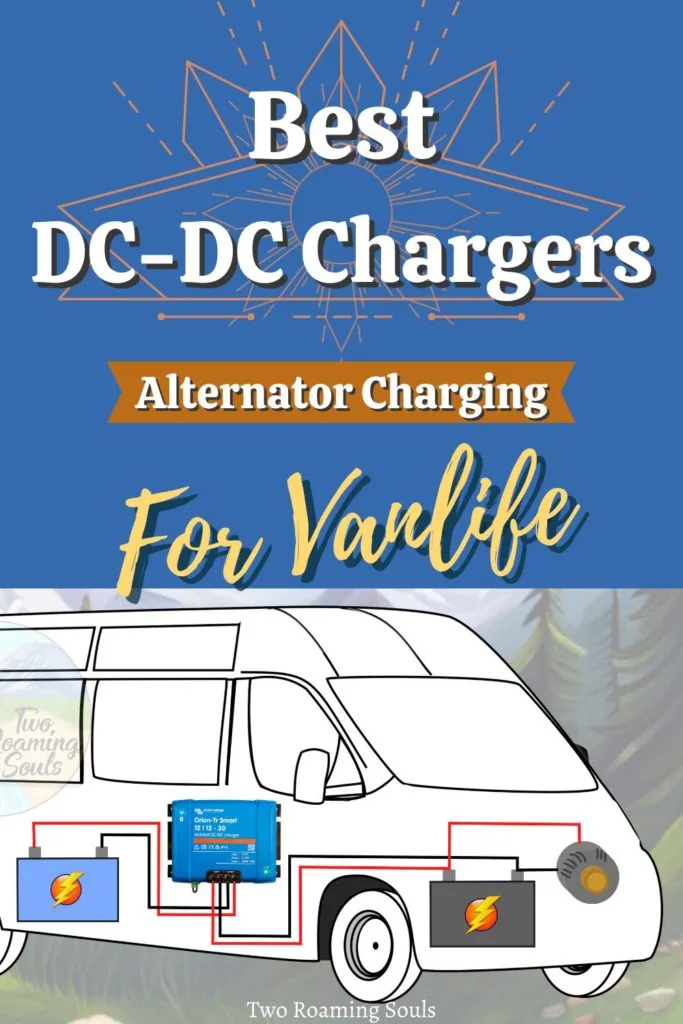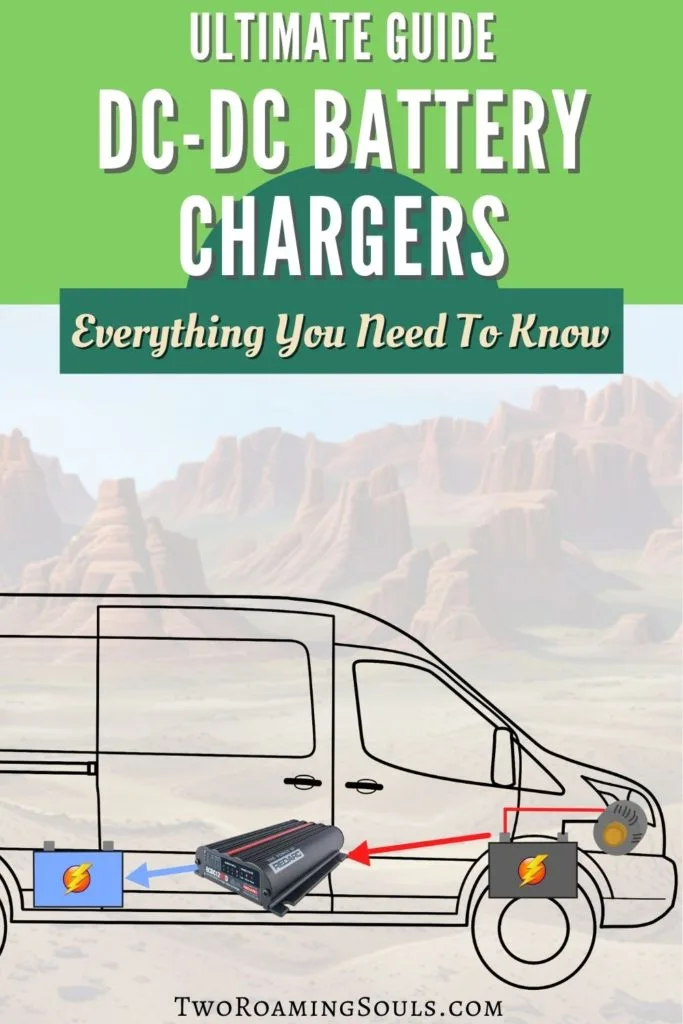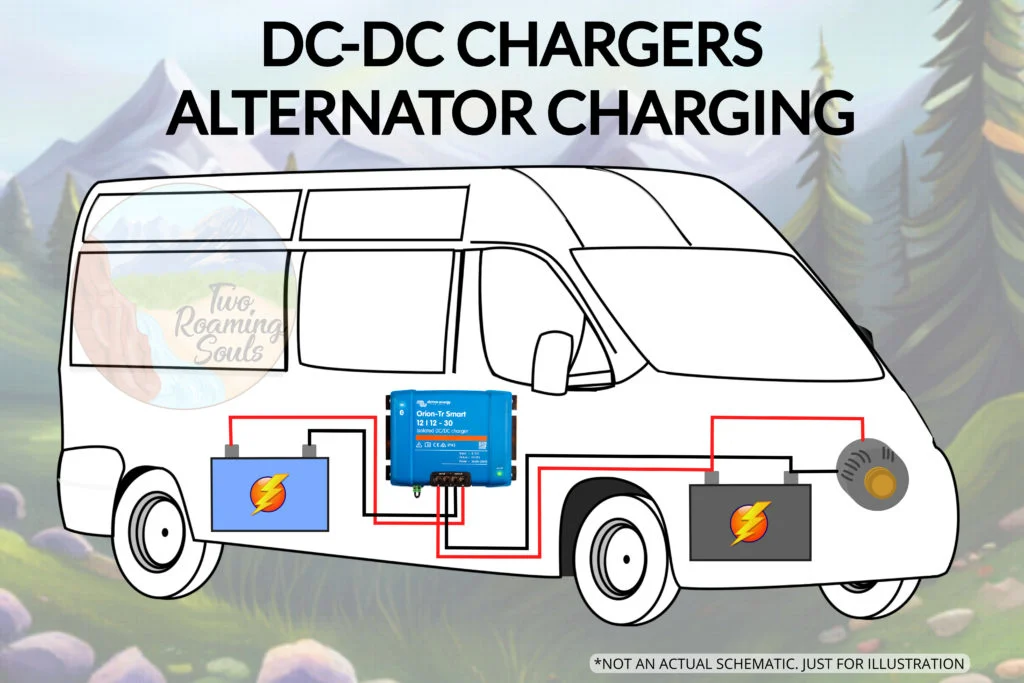
This post explains what a DC to DC Charger is and provides clear guidance on selecting the right one for your needs.
A DC to DC Charger is a device that intelligently uses DC power from your vehicle’s alternator to charge your leisure battery. They also act like an isolator, so that you can’t drain your starter battery. Most DC-DC battery chargers use a diode that only allows current to flow in one direction.
And their primary advantage is the ability to accept variable current and turn it into ideal voltage and amperage for charging your auxiliary batteries.
DC-DC Chargers are typically used as a supplement to power from other sources, like solar panels or gas generators. They can be used as the only source of power (but I don’t recommend it).
DC to DC Chargers can be useful in any vehicle with dual battery systems. They are most commonly found in RVs, campervans, skoolies, off-road vehicles, and boats.
How Do DC-DC Chargers Work?
While they are not all designed the same, the basic function is this…
Every vehicle has an alternator that charges the vehicle’s starter battery (also called chassis battery). A DC-DC Charger allows you to tap into alternator power to also safely charge your house battery (also called leisure battery, auxiliary battery, coach battery).
They will give priority charging to the starter battery before sending charge to your house battery.
DC to DC chargers take the unregulated electrical current (from the alternator) and modify it into a better charging current for your batteries.
Not all DC-DC battery chargers have the same features, but some common features you might find include:
- Multi-Stage Charging (Bulk, Absorption, Float)
- Over-Current Protection
- Under-Current Protection
- Over-Temperature Protection
- Settings for different battery chemistry (lithium, lead-acid, etc.)
- Bluetooth connectivity
- Built-in MPPT solar charge controller
- Reverse polarity for vehicle jump-starting
They are sometimes called Battery to Battery Chargers (B2B Chargers). You connect your house battery in parallel to your starter battery to piggyback alternator charging.
And piggybacking is the perfect term to describe it, because you should never connect your DC-DC Charger directly to the alternator. Always connect it to your vehicle’s starter battery.
How Are DC-DC Chargers Different Than Basic Battery Isolators?
A battery isolator is only a pass-through relay that disconnects your dual battery system to prevent starter battery drain when your engine is off. But they don’t do anything to change or optimize the charge current sent to your auxiliary batteries.
All DC-DC Chargers not only include the basic isolator function to prevent you from draining your starter battery. But in addition, they have “smart charger” features to optimize battery charging and preserve the lifespan of your batteries and alternator.
And keep in mind that some DC to DC Battery Chargers intentionally provide less power than available. They do this for two reasons because charging your battery as fast as possible is not generally good for its lifespan.
You can also wire a manual off switch if you want to be able to turn alternator charging on and off manually. This is sometimes desirable for the more technical folks who wish to manually control their alternator charging (subject to user error). But for most consumers, I think it’s safe to say they want a system that just works on its own.
Single-Input vs Dual-Input DC Chargers
Modern DC to DC Chargers come in two different varieties; Single-Input and Dual-Input.
Single-input chargers only take dc current from the alternator.
Dual-Input chargers can accept dc current from the alternator, as well as a second source (usually solar panels).
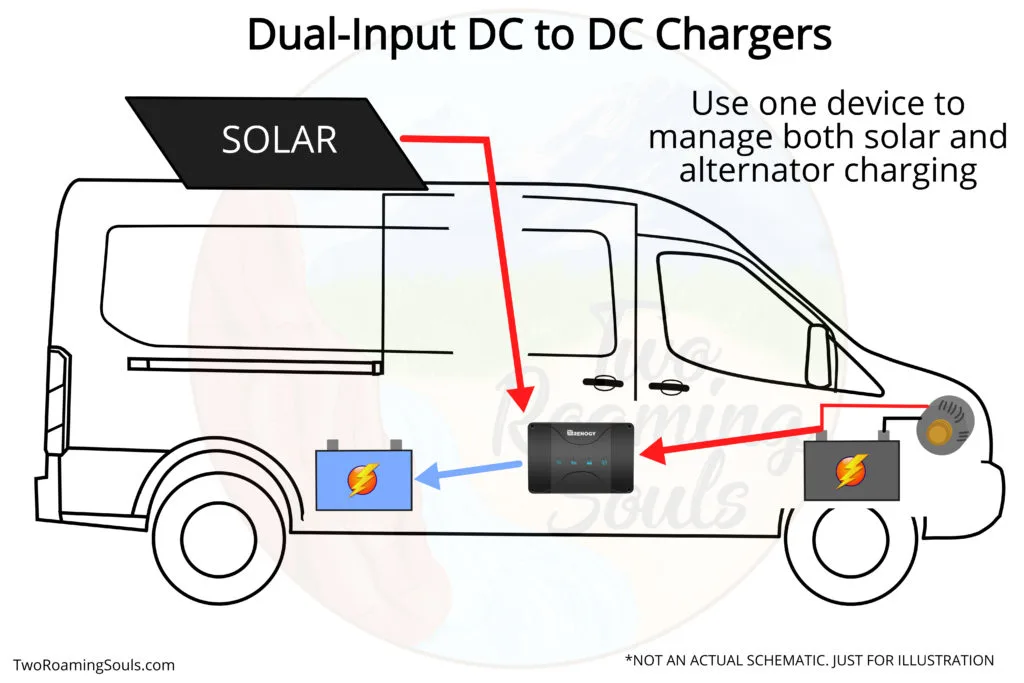
With this dual function, they eliminate the need for a separate solar charge controller.
However, they have a restrictive limit on solar input voltage. And they don’t give you as much control over solar settings as a dedicated solar charge controller.
Comparing The Best DC-DC Chargers
Let’s take a look at the best DC-to-DC chargers. They have a lot of similarities, so let’s focus on specifically what makes them different.
Best Value Dual-Input Charger
Renogy DCC50S
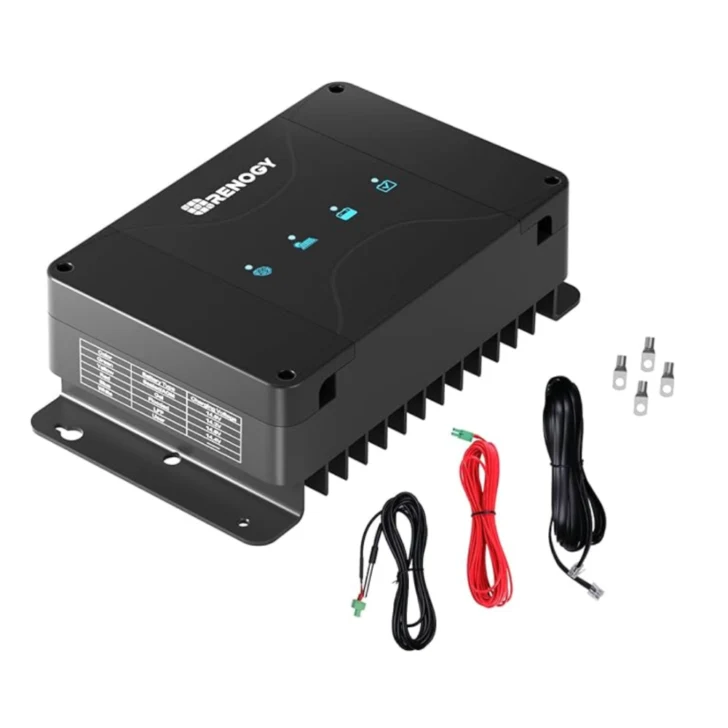
A very reasonably priced DC to DC Charger with built-in solar MPPT charge control.
It’s unique because it can use solar to keep your vehicle’s battery topped off when you are parked. So presumably, you should never need to jump-start a dead starting battery.
It can accommodate Bluetooth monitoring with purchase of separate BT-2 Module.
The biggest drawback is that solar input voltage is limited to 25 volts.
But one thing I don’t like is that it doesn’t give “priority” to maximizing solar power. It simply operates by splitting up to 50-50% between the sources. For example, with the 50amp version, it will take up to a maximum of 25amp from solar and 25amps from alternator.
It comes in either a 50amp or 30amp version.
Best Overall Dual-Input Charger
REDARC BCDC
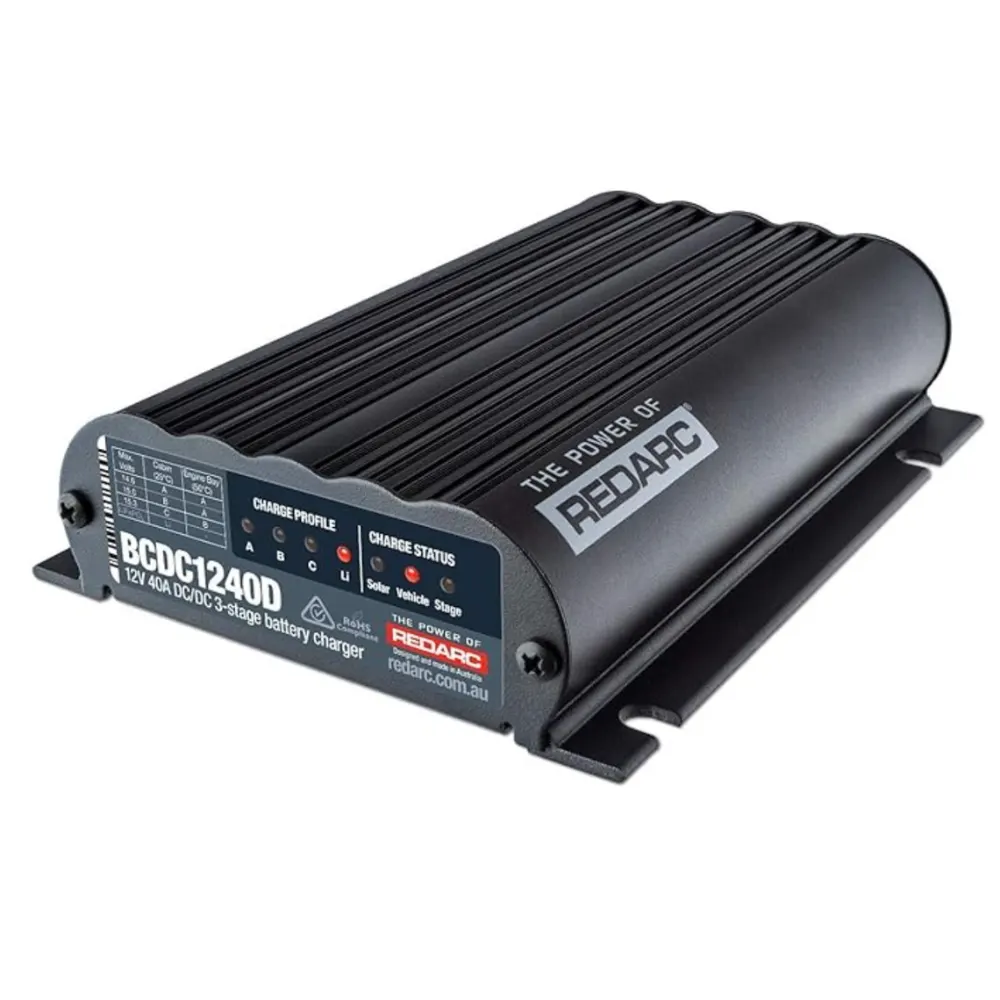
A more expensive premium DC to DC Charger with built-in solar MPPT charge control.
It comes in a 50amp, 40amp, and 25amp version. Learn more about REDARC DC-DC Chargers on their website.
Includes Bluetooth monitoring via smartphone App.
The biggest drawback is that solar input voltage is limited to 32 volts. This is slightly higher than the Renogy chargers above (25 volts). But that limit still isn’t ideal for any solar arrays bigger than 100 watts.
Includes “green priority” charging to always use available solar power before supplementing with alternator power. This lessens the strain on the alternator and maximizes renewable energy.
Best Single-Input Charger
Victron Orion-TR Smart Charger
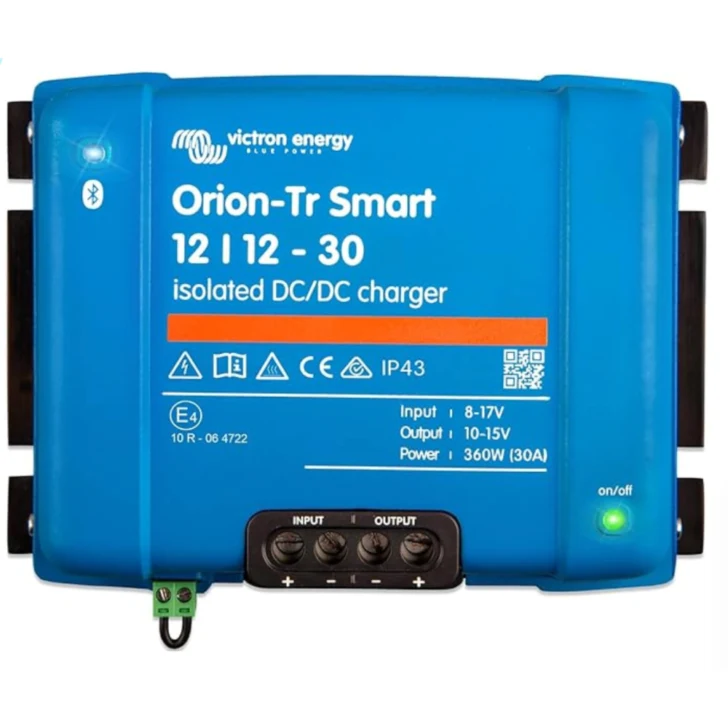
A premium single-input DC to DC Charger with Bluetooth monitoring. Works with all battery types.
Has Bluetooth monitoring via smartphone App included.
This unit does not support solar input. So it’s a good option if you already have a solar system installed and are looking to add alternator charging.
It comes in a variety of different amp and voltage models.
Best Value Single-Input Charger
Renogy DC-DC Battery Charger
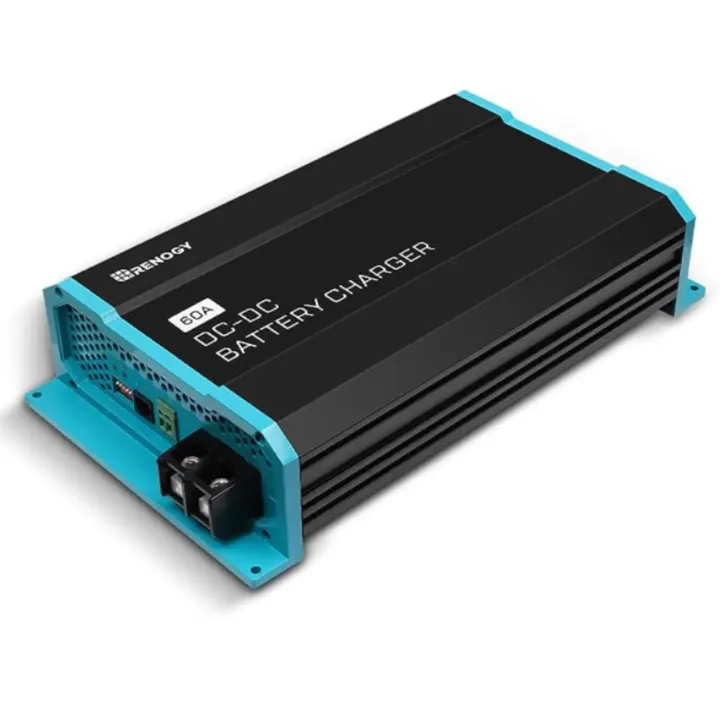
This is the best-value single-input DC-DC Charger. Works with all battery types.
Comes in 20, 40, and 60Amp versions.
No Bluetooth monitoring available.
This unit does not support solar input. So it’s a good option if you already have a solar system installed and are looking to add alternator charging.
Budget-Friendly Single-Input Charger (Lead-Acid Only)
Wirthco Battery Doctor 100A or 150A
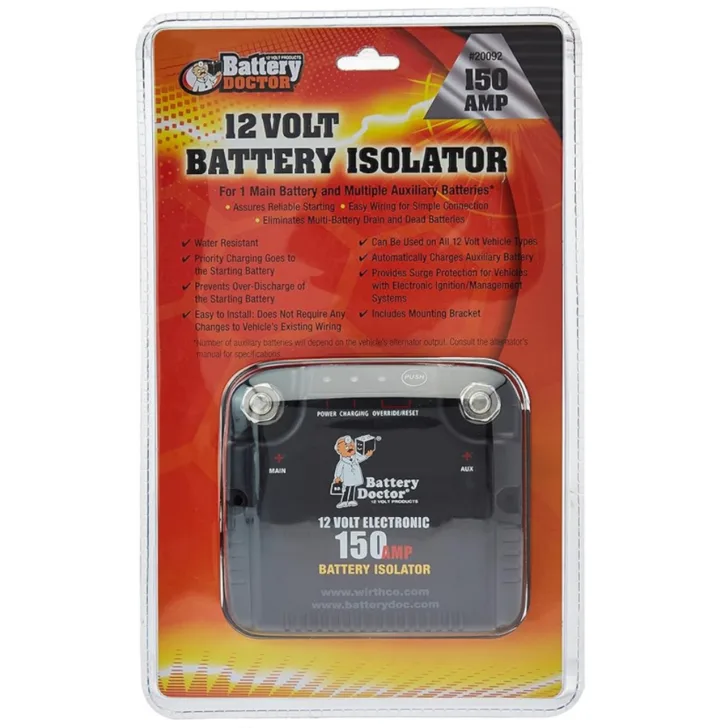
A budget-friendly single input DC to DC Charger for Lead-Acid batteries only.
Doesn’t work with smart alternators.
No Bluetooth monitoring.
Can jumpstart a dead starter battery.
Most Powerful Single-Input Charger (Lithium Only)
Li-BIM 225 Battery Charger
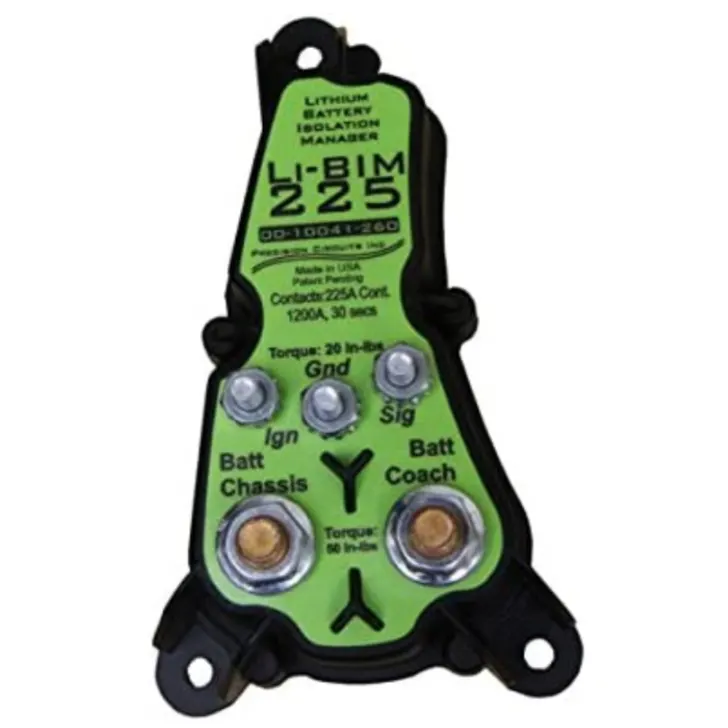
This lithium-specific DC-DC Battery Charger is the most powerful on the list. It’s designed to take advantage of the fact that lithium batteries can handle higher charging rates.
It’s capable of punching up to 225 amps, however the actual limit is much more likely to be your alternator’s available amperage (likely 100amps or less depending on the vehicle).
Conversely, it doesn’t modify voltage, so depending on your alternator, it may not produce high enough voltage to get lithium batteries up to full charge. (Which may not be a dealbreaker if you have other charging sources, like solar).
Its unique feature is a cycle on/off to prevent taxing the alternator too much. When the engine is running, it cycles on for 15 minutes and then off for 20 minutes (and repeats) to give the alternator a break.
Honestly, more power isn’t always better. Despite the cycling and other safety features, it probably taxes your alternator too much. And charging your batteries at the fastest speed isn’t good for their longevity.
And it will require up to 2/0 gauge wire for installation to handle the current. A long run of 2/0 gauge wire is a pricey addition to this installation.
You can use this chart below for quick comparison between some of the best DC to DC chargers.
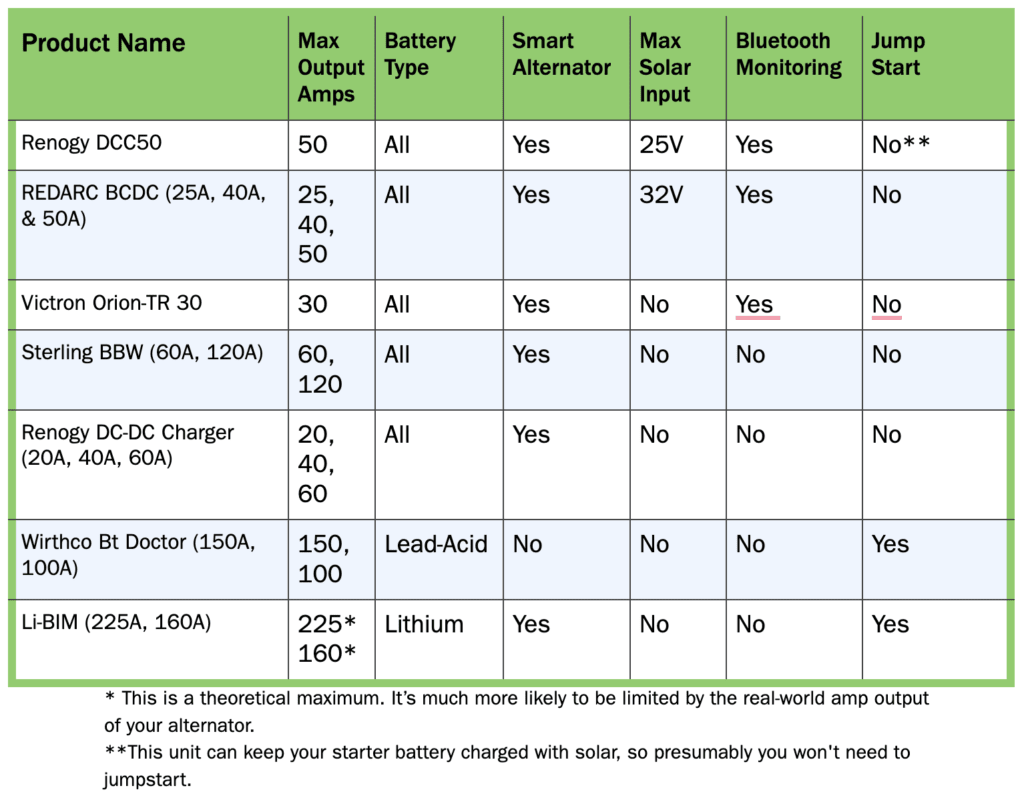
How To Choose The Right DC to DC Charger
The four main things to consider when buying a DC to DC Charger are:
- What is the Amp rating of your alternator?
- Do you have a new vehicle with a smart alternator?
- What capacity and chemistry of your auxiliary battery bank?
- Do you want a DC-DC Charger that handles solar input?
How To Find The Amp Rating Of Your Alternator
The best way to find the amp rating of your alternator is by opening the hood and looking at the alternator itself. There is typically a stamp or placard on it that tells what it is.
However, sometimes this is a little tricky in a van because the engine compartment is so condensed. In our van, we have to remove the air filter housing in order to see the alternator.
Or there are tests you can run to determine what size alternator you have.
Lastly, you may be able to find the alternator specs in your vehicles manual, or by searching online. But you can’t fully trust methods like this if you aren’t the first owner, because a previous owner may have changed the alternator.
Does Your Vehicle Have A Smart Alternator?
If your vehicle is a 2015 or newer, it may be equipped with a smart alternator (variable current alternator). Luckily, most of the newer DC-DC Battery Chargers are compatible with smart alternators.
A smart alternator is a newer style of alternator that can change its current output to compensate for demand. Before their invention, alternators were fixed-voltage, that is, they always generated a constant fixed voltage regardless of state of charge.
So, in the past DC-DC chargers (and battery isolators) could simply operate by detecting the voltage of the starter battery/alternator and turning off and on based on set thresholds.
However, now that smart alternators constantly vary their voltage, DC-DC chargers have had to include an ignition sensor. This is a different way of “telling” the DC to DC Charger when the engine is on.
What Kind Of Batteries Are You Charging?
Amperage
How big is your auxiliary battery bank? This number is usually expressed in AmpHours (Ah) per battery. If you have multiple batteries (in parallel), you can simply add them together to get the total size of your battery bank. Most manufacturers will recommend a certain model based on the size of your house battery bank.
Voltage
Most smaller off-grid vehicle electrical systems used 12-volt deep-cycle batteries. Thus, most DC-DC chargers are designed for 12v batteries.
But in RVs and skoolies, sometimes the electrical system (either starter or leisure) uses 24v or 48v batteries. In this case, you need a DC to DC Charger that works with high voltage.
Check out the Victron Orion 24v or 48v models, REDARC 24-volt Models, and Sterling BBW122460.
Battery Chemistry
Most newer DC to DC Chargers are designed to be adaptable to different types of batteries (i.e. lithium, lead-acid, AGM, gel, etc.). The Victron Orion TR, Renogy DCC50S, and Redarc BCDC all have settings that allow them to work with nearly any battery chemistry.
They do this by allowing different charging profiles to account for different battery chemistries. These alter the voltage settings for each different state of the charging process (bulk, absorption, float).
However, some older DC to DC battery chargers are designed for only one type of battery chemistry. For example, this Wirthco Battery Doctor, only works with Lead-Acid batteries. This Li-BIM Charger only works with Lithium batteries.
Do You Want A DC-DC Charger With Solar Input?
Some newer DC to DC Chargers can handle two inputs of power, typically, solar and alternator. The two units discussed in the article that do that are the Renogy DCC Models and the REDARC BCDC Models.
They both include MTTP (maximum power point tracking) charge control, which is the most efficient solar charge controller technology.
These combo units are great because they can do the job of two separate units (solar regulator and DC-DC charger). This can be a benefit for cost, physical space, wiring, and complexity.
However, the one HUGE drawback to these type of units is they (currently) only allow a small input voltage from solar panels.
For larger solar panel arrays, you will need to wire them in parallel to stay under that voltage threshold. And wiring solar panels in parallel is not the preferred method for campervans. (It reduces the amount of time your array produces power and adds more cost and wiring complexity).
Or in our case, we have a single 320-watt residential panel on our campervan, which by itself can produce more voltage than these modules can handle.
So if you are planning a vehicle solar system from scratch AND you plan to have a smaller solar array, then these dual-input DC-DC chargers are potentially a good option.
However, if you want to add alternator charging to an existing solar setup, or you are planning a new system with a medium to large solar array. Then you are probably better off having a standalone DC-DC charger (Victron Orion-TR, Sterling BBW, Wirthco Battery Doctor, Li-BIM 225) and a separate MPPT solar charge controller.
How To Choose The Right Size DC-DC Battery Charger
DC to DC chargers are primarily rated by amperage output. However, they also will be rated for voltage input and output (as we discussed above).
To choose the right size DC to DC battery charger, you need to consider what kind of house batteries you have.
For lithium batteries, you can charge at up to 50% of capacity (0.5C).
For lead-acid batteries (Gel, AGM, FLA, etc.), you can charge at up to 20% of capacity (0.2C).
But always consult the manufacturer’s spec sheet to double-check.
So, you can take that percentage of your battery banks’ total amp capacity to find the MAXIMUM acceptable amperage.
Examples:
100Ah Lithium battery bank (100 x 0.5) = 50amps maximum
200Ah Lithium Battery Bank (200 x 0.5) = 100amps maximum
100Ah Lead-Acid Battery Bank (100 x 0.2) = 20amps maximum
400Ah Lead-Acid Battery Bank (400 x 0.2) = 80amps maximum
You can certainly charge your batteries with lower amperage, but you definitely don’t want to go over.
Reasons that you might choose to charge with fewer amps than allowed:
- Lithium batteries can often handle more than most DC chargers put out.
- Smaller amp DC-DC Chargers are cheaper.
- You get plenty of power from solar and are okay with a smaller amount of supplemental alternator charging.
- Lower amp charging can improve alternator and battery lifespan.
- Smaller and cheaper wiring and fuses needed for installation.
Are There Any Downsides To Using A DC to DC Charger?
Yes, there are some potential downsides to using a DC to DC Charger/Isolator. In addition to the aforementioned solar input voltage limit, there is one other glaring negative.
While DC-DC Chargers may come with features to protect your batteries and alternator, ultimately they still cause your alternator to work harder and more often.
An alternator will wear down and eventually need replacing just like any other mechanical part.
So making it do more work regularly will likely shorten it’s lifespan. There’s no hard fast rule for alternator lifespan, but a solid estimate is between 80,000 and 150,000 miles.
And if you intentionally go off-grid often, it could leave your vehicle stranded with a dead alternator. Ironic, considering that many people appreciate some DC-DC chargers for their ability to jump a dead battery.
So with this said, I believe that (when possible) solar panels should be your primary way of charging your leisure batteries. Obviously, if you live somewhere with very little sunshine, then you might want to rely more on alternator charging.
How Fast Does A DC-DC Charger Charge Your Batteries?
If you are hoping that you can just idle your engine for 20 minutes and recharge your entire 200Ah battery bank, then sadly, I need to crush your dreams. These B2B chargers are not magic.
In fact, depending on your alternator and battery bank, your engine needs to be working pretty hard to even create enough power.
And you should never idle your engine as a means of charging because you can overheat your alternator.
You need to consider the amp rating of your charger, the amp rating of alternator, the size of your battery bank, and the amount of time spent driving.
There are several factors that make it difficult to determine exactly how fast a dc-dc charger will charge your batteries.
- Actual alternator output doesn’t match it’s full rated output (likely only 50-70%).
- Some percentage of amp hours are devoted to the starter battery and vehicle electronics.
- What kind of driving you are doing (highway, city, traffic)
Conclusion | Best DC to DC Charger For You
There is certainly a lot of information to understand about DC to DC Chargers. But here are some final thoughts about choosing the right one.
My top choice for value, performance, and features is the Victron Orion-Tr Smart. It’s what I recommend for most people.
When To Choose A Single-Input DC-DC Charger
If you already have an existing solar power system and simply want to add alternator charging, and/or your system has a solar array larger than 100w…
Then choose one of the single-input dc-dc chargers (Victron Orion, Renogy DC-DC Charger, Sterling BBW).
Choosing which one you want kind of depends on your philosophy, electrical needs, and budget. There is a trade-off between amp output and load on your alternator. It’s very difficult to quantify, but still something you should consider.
Low Amps Philosophy
You can aim for a low amperage charger (20-30A) that puts less strain on your alternator. Your house batteries won’t charge as fast while driving, but you might be okay with that trade-off especially if you have plenty of solar power coming in. And your alternator (theoretically) will last longer.
Good options in this range are the Victron Orion-TR 12 | 12-30 ($$) and Renogy 20A DC-DC Charger ($).
Medium Amps Philosophy
Or you can aim for something in the middle amperage range (40-80A). This offers a decent balance between charging power and load on the alternator.
Good options in this range are Renogy DC-DC 40A and 60A ($$), and Sterling BBW 60A ($$$).
High Amps Philosophy
Or you might choose to put much more emphasis on alternator charging with a high amperage model (100A+). You will be able to charge your batteries faster but at the expense of increased load on your alternator. This can compensate for a weak solar array (or none at all if you want to do vanlife without solar).
If you go this route, you may want to consider upgrading your alternator to one with higher amps. The vehicle’s factory alternator is probably not designed for this much additional load.
Good options in this range are Sterling BBW 120A ($$$), Li-BIM 225 Lithium ($$), Wirthco Battery Doctor Lead-Acid ($)
Dual-Input DC to DC Chargers
Having a DC-DC Charger and Solar Charge Controller all packed into one unit is a really awesome technological advancement. The REDARC BCDC line and Renogy DCC line are superb products that can be perfect for the right setup (i.e. small solar input). And there is great simplicity and savings by having just a single unit handle two inputs.
The top-of-the-line dual-input chargers are made by REDARC: BCDC 50Amp, BCDC 40Amp, & BCDC 25Amp.
The more budget option is to choose the Renogy DC Chargers: Renogy 50Amp Charger or Renogy 30Amp Charger.
But why is the REDARC BCDC so much more expensive than the Renogy DCC? Renogy is more of a budget-minded company, whereas Redarc specializes in extra rugged products geared toward off-road vehicles.
Their REDARC Classic BCDC can be mounted inside the engine compartment and handle extreme temperatures and vibration. Though that’s likely irrelevant because most campervans mount the charger inside the cabin. And the Renogy DCC units seem to hold up just fine for life on the road.
REDARC also has the in-cabin “BCDC Core” lineup of chargers. But they are still very pricey compared to Renogy.
Ultimately, the two companies’ products are pretty similar when you just compare spec sheets.
What I like most about REDARC over Renogy, is that their units accept slightly more solar input voltage (32 volts vs 25 volts). And they give utmost priority to solar and supplement with alternator power as necessary. The Renogy DCC units simply split (up to) 50%-50%.
The future is probably headed toward more dual-input DC-DC Chargers that can handle all your solar and alternator charging. However, the products currently available put an unreasonably low limit (IMO) on solar input voltage.
Thus forcing buyers to have a tiny solar array or wire their panels in parallel. Both of which are suboptimal. They practically force you to rely more on alternator charging with such low limits on solar.
Solar panels are cheap and I spend most of my time in the Western US, where sunshine is abundant. So at least for me, I am hoping that future dual-input DC to DC Chargers can accommodate much more solar power.
Only then, will I crown them the best all-in-one solution for battery charging.
Help Share This Guide About DC-DC Chargers On Pinterest!
